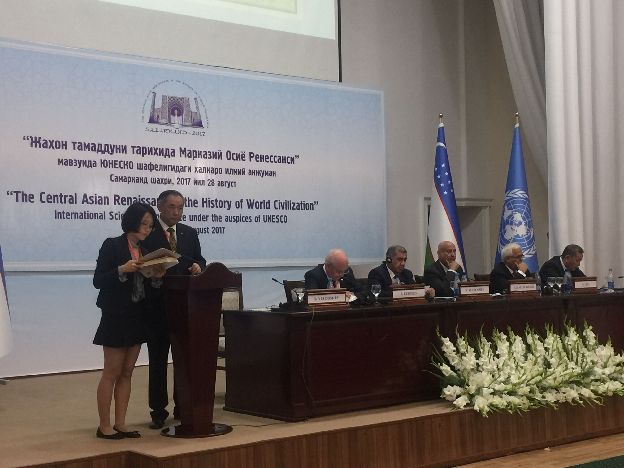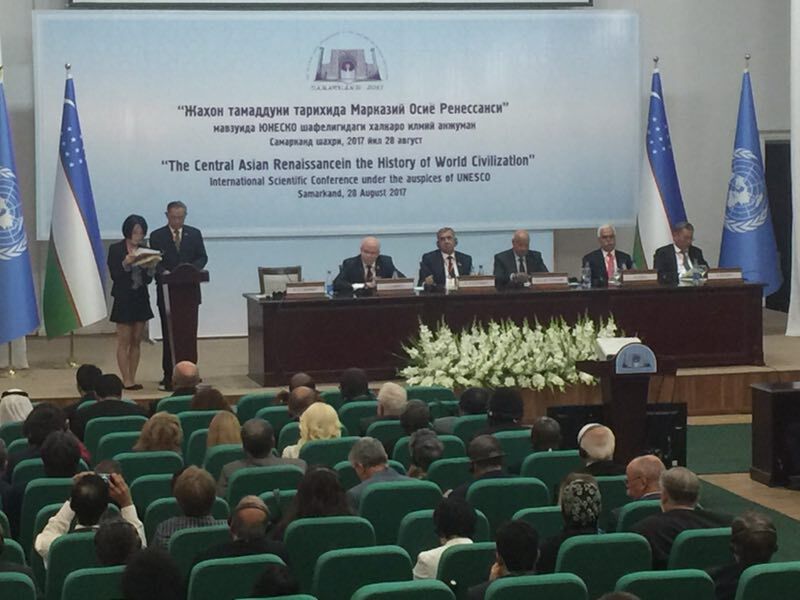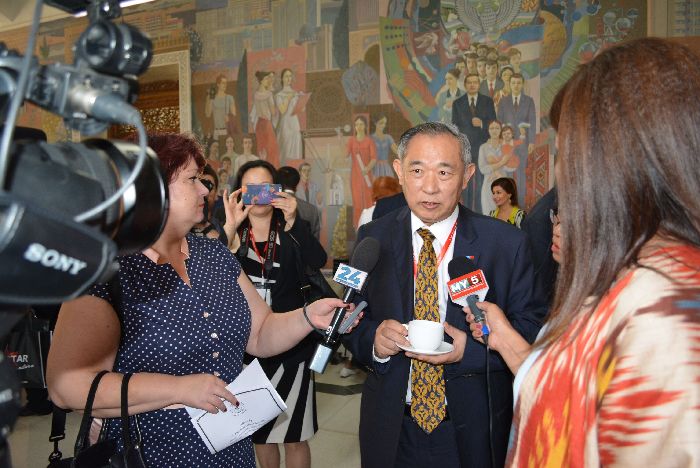

On August 28, upon the invitation from Vice-Premier of the Republic of Uzbekistan and officials from UNESCO, a delegation headed by Dr. Li Ruohong, President of China World Peace Foundation and Beijing International Peace Culture Foundation participated in the conference and Dr. Li delivered a speech along with Dr. Nigmatilla T. Yuldashev, Speaker of the Senate of Oliy Majlis of the Republic of Uzbekistan, Dr. Taleb Rifai, Secretary-General of UNWTO, Dr. Badarch Dendev, Head of UNESCO office in Uzbekistan, Mr. Sergey N. Lebedev, Chairman of the Executive Committee and Executive Secretary of the CIS and Dr. Abdulaziz Bin Othman Al-Tuwaijri, Director General of the ISESCO. The government and parliament of Uzbekistan, foreign diplomatic envoys stationed in Tashkent and UNESCO representatives also took part in the conference. 
The guests reviewed the outstanding achievements of the splendid history of civilization in Uzbekistan and its sages’ indelible contribution in the fields of science and technology, literature, education, philosophy, religion, spirit and culture for the Islamic as well as world civilization. They also elaborated the rosy vision and action plan for the revival of Central Asia Civilization.
In his speech during the plenary session, President Li gave the example of Zhang Qian, an ancient Chinese diplomatic envoy whose visit to Xiyu (the western part of China) has launched the interaction in public diplomacy, economy and culture along the Silk Road. Today, China's Belt and Road Initiative bonded by people’s connectivity will play a positive role in promoting the great unity for the people around the world. China has now become the most important investment and trade partner of the Central Asian countries. Both sides have strong complementarity in science and technology, energy, agriculture and infrastructure. They should strengthen mutual understanding and expand tourism and education cooperation so that the younger generation can know each other better and share the fruits of development in dialogues. President Li also introduced guests from various countries an interactive cultural atlas of cultural interactions along the Silk Roads, a project co-developed by his Foundation and UNESCO. He pointed out that, as a brand project, the revival of Central Asia should combine information technology and traditional ways to inherit and develop the regional civilization, spread sustainable positive energy in the Belt and Road, and bring into full play of traditional civilization in Central Asia in industrial and information technology.
 After receiving media interviews by Uzbekistan state TV, President Li watched Sharq Taronalari oriental music festival at Registan Square along with all delegates and H.E. Shavkat Mirziyoyev, President of the Republic of Uzbekistan. Toward the end of the event, both Li and President Mirziyoyev sent regards to each other and the latter welcomed the arrival of the Chinese delegation by raising his thumb up.
After receiving media interviews by Uzbekistan state TV, President Li watched Sharq Taronalari oriental music festival at Registan Square along with all delegates and H.E. Shavkat Mirziyoyev, President of the Republic of Uzbekistan. Toward the end of the event, both Li and President Mirziyoyev sent regards to each other and the latter welcomed the arrival of the Chinese delegation by raising his thumb up. - Li Ruohong delivered a speech and signed amendment at the UNESCO Silk Road Dialogue Conference
- Li Ruohong attended the "2025 Beijing Catering Industry High Quality Development Conference"
- Celebrating the 59th Anniversary of Guyana's Independence and Promoting International Exchange and Cooperation
- Peace Garden held Silk Road Latin American and Caribbean International Community event
- H.E. Mr. Saleem Mandviwalla and Dr. Li Ruohong jointly discuss the development of China Pakistan cooperation
- Li Ruohong and Belgian Ambassador to China established Peace Garden Diplomatic Club
- Li Ruohong met with Ambassador of Lesotho to explore new opportunities for international cooperation
- Li Ruohong attended the historical photos exhibition of China&Pakistan leaders and spoke in the panel
- Li Ruohong and foreign ambassadors to China explored Silk Road cuisine culture
- Li Ruohong attended West Nordic Day celebration to explore new opportunities for international cooperation
“一带一路”文化互动版图:音乐与艺术 | 科学技术与技能 | 医术与医药 | 服装与服饰 | 美食与农业 | 神话与幻想 | 传统竞技与体育 | 语言与文学 | 仪式与庆典 | 宗教与精神
An Interactive Atlas of Cultural Interactions along the Silk Roads: Arts and Music | Seience,Technology and Know-how | Pharmacology and Medicine | Costumes and Clothing | Food and Agriculture | Mythology and Fantasy | Traditional Games and Sports | Languages and literature | Rituals and Celebrations | Religion and Spitituality


